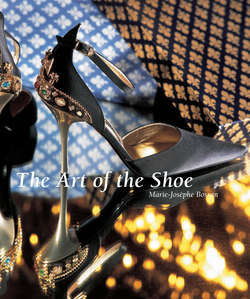Читать книгу The Art of the Shoe - Marie-Josèphe Bossan - Страница 6
На сайте Литреса книга снята с продажи.
From Antiquity up to our days
Ancient Egypt
ОглавлениеAncient Egypt was the home of the first sandals. This form of flat shoe with straps arose in response to Egypt’s climate and geography.
King Narmer’s Palette from around 3100 BC reveals that a servant called a “sandal bearer” walked behind the sovereign carrying the royal sandals on his forearms, indicating the importance henceforth attached to the shoe in ceremonial garb.
Although often depicted barefoot in Egyptian wall paintings, men and women also wore sandals. Egyptian sandals were made of leather, woven straw, strips of palm or papyrus leaves or from the rushes and reeds that grew in the marshes. The Pharaoh and the socially prominent had them made of gold, though sandals were a luxury item for everyone. Tomb excavations have revealed that this object, originally strictly utilitarian, had a social function. The sandal maintained continuity of form throughout Pharaonic civilization and lasted until the Coptic era of Egyptian Christianity. When the pharaoh entered the temple, or when his subjects celebrated the cult of the dead in funeral chapels, they removed their sandals at the sanctuary’s entrance, a custom later adopted by Muslims upon entering a mosque. The ritual demonstrates the strong relationship that exists between the shoe and the sacred, a relationship that is also established by specific biblical passages, which will be discussed below. The advent in Egypt of the raised-tip sandal in the second millennium BC is probably a Hittite influence. It is the precursor of the poulaine, or piked shoe, an eccentric medieval fashion introduced to Europe from the East by the Crusades. When sandals are among the items packed for the mummy’s afterlife, they are placed in chests or illustrated on horizontal bands decorating the painted interior of the wooden sarcophagi. Evidently, their role was prophylactic.
Texts from the era of the pyramids allude to and reflect the wishes of the dead “to walk in white sandals along the beautiful paths of heaven where the blessed roam.”
8. Wooden sandals inlayed with gold, treasure of Tutankhamen. 18th Dynasty, Thebes. Cairo Museum, Cairo.
9. Egyptian sandal of plant fibers. Bally Museum, Schönenwerd, Switzerland.
